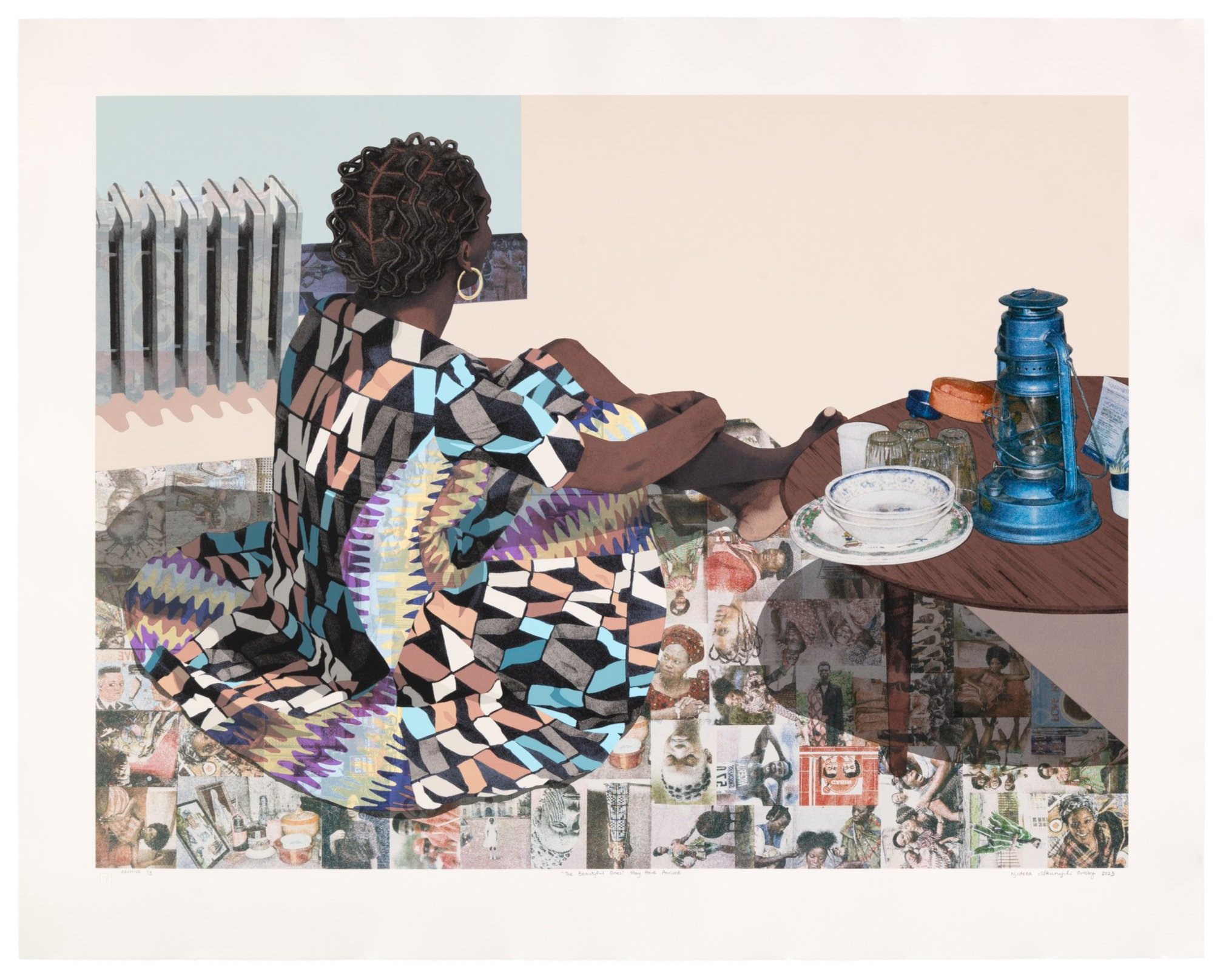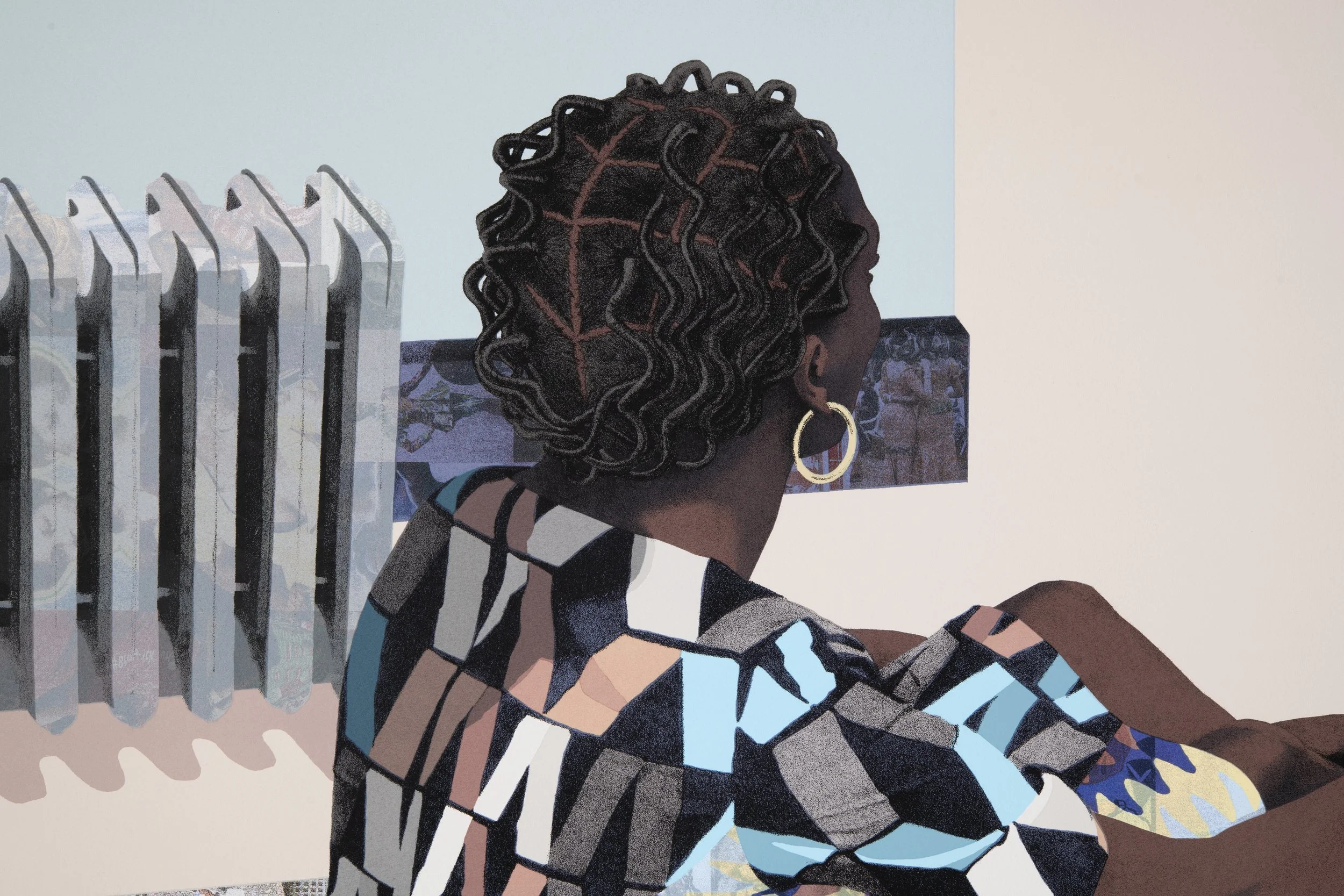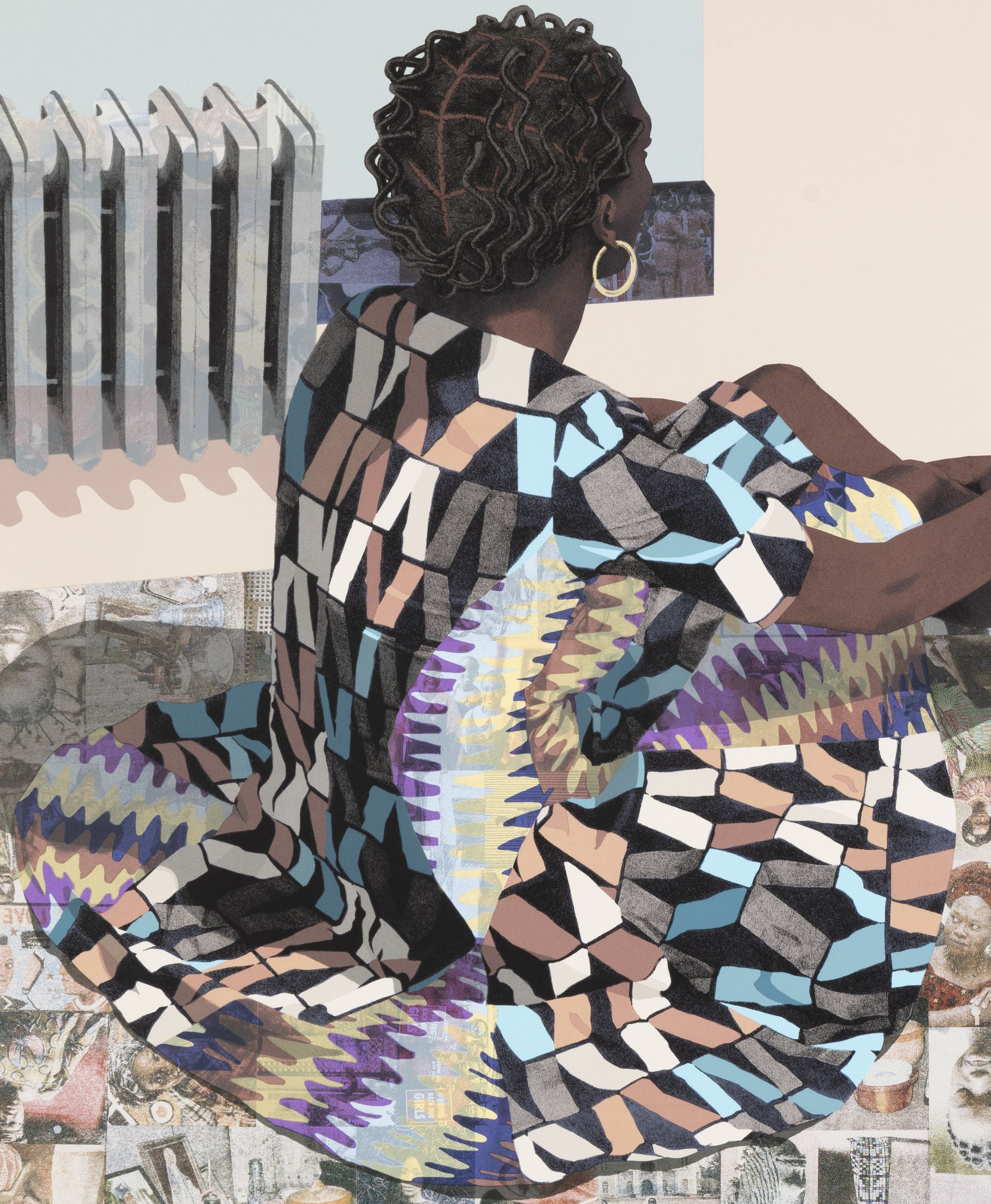Njideka Akunyili Crosby’s new print, “The Beautyful Ones” May Have Arrived, represents her first foray into an area of artistic production that she has been considering for some time. It is both a statement of continuity with the subject matter and style that has dominated her painted work for over a decade, and a novel departure in terms of process and materials.
The design is related to an acrylics-and-transfer-on-paper painting from 2013 titled “The Beautyful Ones Are Not Yet Born” Might Not Hold True For Much Longer, now in the collection of the Nasher Museum of Art at Duke University. At five and a half by seven feet, it was the precursor to a celebrated series of works, “The Beautyful Ones,” derived from the debut novel by Ayi Kwei Armah from 1968. Armah was born in Ghana in 1939, and his book centers on the challenges in the life of a working-class man in the weeks leading up to the coup against Kwame Nkrumah’s government in 1966. Akunyili Crosby’s continuing series, now encompassing eleven paintings, thus takes post-colonial Africa as its starting point, and presents frontal portraits of youthful relatives, friends, and herself in intricate interiors and complex clothing. This initial image from 2013 is different from the others in the body of work as the protagonist, the artist herself, is seen in profil perdu, and the viewer is left to imagine her state of mind. In both the present print and its painted inspiration, a woman sits on a rug next to a low table on which rests a variety of objects, including a kerosene lantern, bowls, and plates. There is a radiator to the left of her head, and a wall with a baseboard. She wears an Ankara dress and sports a distinctively threaded hairstyle.
Detail, “The Beautyful Ones” May Have Arrived
The painting was produced in Akunyili Crosby’s signature method, through precise drawing, the use of acrylic paints, and a photo transfer technique. The latter entails transferring images sourced from the internet or photographs she has collected over many years that serve as a kind of personal lexicon in her pictures. Pictures from this image bank are laser printed onto sheets of paper, and these color photocopies are placed face down onto the final surface and rubbed with acetone, transferring the image onto the paper below. The result is then often given a whitewash to further cloud the transferred image and push it back into the illusionistic space of the picture. This is a kind of monoprinting, and its ghostly reversed effects are visible in the radiator, baseboard, rug, side of the dress, edge of the table and its legs. In a gesture with metaphysical resonance, Akunyili Crosby painted a still life on the tabletop based on objects she photographed in 2012 at her grandmother’s house in a countryside village outside the town of Enugu where the artist grew up. Photographs of these same objects are then transfer printed onto the side and legs of the table.
In adapting such a complex work for an autonomous print, Akunyili Crosby and master printer Cole Rogers of Highpoint Center for Printmaking in Minneapolis needed to be both flexible in the process and rigorous in the determination of colors and textures. As a result, their collaboration has taken four years. Akunyili Crosby had been inspired by printmaking classes at the Pennsylvania Academy of Fine Arts and then at Yale University, where she studied under Rochelle Feinstein. She was also greatly influenced by prints made by artists such as Kerry James Marshall and Julie Mehretu. Rogers had first seen Akunyili Crosby’s work in person in a show of five pictures titled I Still Face You at Franklin Art Works in Minneapolis in 2013. The eventual collaboration has taken four years. Initially, Akunyili Crosby drew the intricate design onto a large lithographic limestone, sourced by Rogers from the stock of a deceased printmaker in New Mexico, who had probably procured it from the famed Solnhofen quarries in Germany. The plan was to employ a combination of oil-based lithography and water-based-ink screen printing, but in the end it was decided to scan the image printed from the stone, making forty-five screens from the scan, and employing an astounding forty-three specially mixed colors in the printing process. The result is printed on Rives BFK paper, the same support that Akunyili Crosby uses for her paintings. In the sections that approximate her trademark image-transfer work, a transparent grayish whitewash is applied to push the image into the perceived background. The radiator, for example, is printed using four different transparent colors to locate it in deeper space. Such intricacies of the process mitigate against the tendency for screen-printing to result in opaque and flat surfaces, and successfully convey the distinctive way Akunyili Crosby crafts her paintings, preserving their essence in this independent work.
Detail, “The Beautyful Ones” May Have Arrived
In “The Beautyful Ones” May Have Arrived, Akunyili Crosby amplifies elements of the source image while adding new details, such as the gold hoop earring and the four inverted glasses on the table. She made both feet visible including a big toe and heel, added a bit of the left arm, and turned the subject’s face to the right to make the slit of her eye and her high cheekbone visible. She also transformed the table from rectangular to circular to better harmonize with the round pooling of the dress on the rug, the table’s shadow, that earring, and the various round bowls and plates and lantern and glasses on the table. Most critically, she deleted the narrow threshold at the upper right and the continuation of the wall and baseboard, in favor of a suggestive void that begins mere inches from the sitter’s face.
The most complex element of the print is the sitter’s fabulous dress. This is in an Ankara style, employing traditional African patterns in a wax-based process on cotton that is itself, of course, a kind of printing. Based on a design from Boxing Kitten in Brooklyn, it is built of sections like puzzle pieces, a combination of many colors and various levels of transparency. The wavy patterns are echoed in the complex hairstyle derived from images of threaded hair by Nigerian photographer J.D. ‘Okhai Ojeikere (1930—2014), who began shooting these traditional looks in the 1960s. As with so much of Akunyili Crosby’s work, there is an architectonic quality to the dress and hair, signaling an awareness of the modernist design that marked the landscape of post-colonial Africa, especially the metropolitan Lagos of her youth. The artist’s works are often built on such design scaffolds; they combine with her beautiful drawing of faces and bodies and her challenging use of perspective to enliven the compositions and establish physical settings for the sitters’ mental musings.
Detail, “The Beautyful Ones” May Have Arrived
In works such as “The Beautyful Ones” May Have Arrived, Akunyili Crosby instills a sense of inner life into her figures who are presented in domestic environs that meld the Nigeria of her youth and the America of her maturity, and that literally bear their histories and culture—printed onto the metal of the radiator, the wood of the baseboard and table, the broad seams of a dress. These somewhat washed out visual sparklings press back into the depicted image but simultaneously and animatedly burst forward into the mind, in the forms of the hopes and dreams of the young sitter, who stares out into a light manilla-hued void, enveloped by the past but expectant and embracing of the future.
Jason Rosenfeld
Thank you to Njideka Akunyili Crosby, Cole Rogers, and Andre Keichian for their help in the writing of this essay.
Jason Rosenfeld, Ph.D., is Professor of Art History at Marymount Manhattan College, New York, and a Senior Writer and Editor-at-Large at The Brooklyn Rail. He is the co-author of a monograph on Cecily Brown (Phaidon, 2020). He was co-curator of the exhibition River Crossings at Cedar Grove, the Thomas Cole National Historical Site, in Catskill, New York, and Olana, in Hudson, New York (2015); co-curator of Pre-Raphaelites: Victorian Avant-Garde at Tate Britain, London, the National Gallery of Art, Washington, DC, the State Pushkin Museum of Fine Arts, Moscow, the Mori Arts Center Gallery, Tokyo, and the Palazzo Chiablese, Turin (2012-2014); and co-curator of John Everett Millais at Tate Britain, the Van Gogh Museum, Amsterdam, the Kitakyushu Municipal Museum of Art, Fukuoka, and the Bunkamura Museum, Tokyo, Japan (2007-2008). He is the author of the monograph on John Everett Millais (Phaidon, 2012).
View availability of the work here and for all inquiries, please email the Gallery Director, Alex Blaisdell, alex@highpointprintmaking.org




